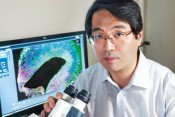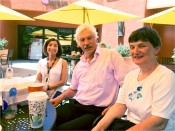|
L&Mint-int-4-2014
>
Sasai’s Death
Sasai’s DeathIt was a Tuesday morning in early August. I’d just returned to my office from a trip to the US. I’d been at an eye conference, ISER 2014 in San Francisco, where I’d heard about recent work in growing human retinal tissue from stem cells. Still reeling from all the new data and numbed by jetlag, I’m trying to marshal my thought processes, writing endless mails to colleagues and making a pig’s ear of my travel expense forms. As I am putting together a figure for a manuscript (fig.1), one of my doctoral candidates appears at the door, somewhat pale, not his usual self. “What’s up?” He takes a deep breath: “Sasai is dead. Looks like suicide. My wife read about it this morning in the Japanese news [author’s note: she is Japanese]. It’s not 100% certain that it’s our Sasai, but it probably is him.”
Yoshiki Sasai The image on the monitor shows one of his optic cups grown from iPSCs.
Yoshiki Sasais state as a stem cell biologist had rocketed overnight when he and his team had produced artificial optic cups from a novel type of murine stem cells. His publication in Nature stunned the fields of regenerative medicine and eye research [1], and was also the reason that the name Sasai had been on everyone’s lips at the ISER congress. One starting point Sasai cited for his work was a study by Nakagawa from 2003, which itself had been based on our “mini-eyes” from chick retina [2] (see also q&more 2/11). The genealogical proximity of our work meant we therefore thought of him as “our Sasai”. One can easily imagine how thrilling all of this was for me: after all, we had been the first to show – as early as the 1980s – that isolated stem cells of embryonic chick retina can be used to grow balls of cells with complete cell sheathing (we dubbed these retinal spheroids or “mini-eyes”, fig.1), and had thus delivered a proof-of-principle for these most recent research developments [3–5]. The ultimate step – implantation of this tissue into blind patients – was to be taken very soon. Dr Magdalene Seiler has been researching the transplantation of foetal retinal tissue into the eyes of blind experimental animals for many years, which has led to several clinical successes [6] (fig.2).
Fig. 1: Surprising similarity between the highly structured retinal spheroids originally grown in the 1980s from embryonic chick retina by the team led by Paul Layer, top, (Prog Ret & Eye Res, 1994, 13, 197–230) and those now grown by Zhong et al. 2014 from human iPSCs, bottom, (Nature Commun 5, doi: 10.1038/ncomms5047). The black clumps of cells are retinal pigment epithelial (RPE) cells.
Fig. 2: Dr Magdalene Seiler (right) of the UC Irvine Medical Centre has spent decades researching the transplantation of foetal retinal tissue (see article). Pictured here with one of her colleagues (Anuradha Mathur, left) and the author at lunch in Irvine, August 2014.
And now, the news that Sasai has taken his own life. We’re shocked, but the chain of events is clear to me immediately. Sasai’s death isn’t about his artificial optic cups, nor is it about a scandal involving Rosi: it’s all to do with the controversy that’s been raging since early this year over Haruko Obokata, principal investigator at the renowned RIKEN Centre for Developmental Biology (CDB). It’s about her results, which she was also able to publish prominently in Nature [7, 8]. Before we go on, one should first know that in regenerative medicine, the search is still on for the most suitable stem cells, which can then be multiplied quickly and grown into tissue – so as to be able to replace diseased tissue or organs. But which kind should be used? Embryonic or adult stem cells (ESCs, ASCs), pluripotent or multipotent stem cells? All have their individual problems. Only with cells known as “induced pluripotent stem cells” (iPSCs) did it seem as if the Holy Grail had been found. Once again, it was a Japanese team that in 2006 published a method for manufacturing iPSCs from adult cells. In 2012, Shinya Yamanaka received the Nobel Prize for this work – an entirely justified decision given its expected medical and economic significance. This method is now being used worldwide in many labs, although it is a highly complex procedure. Accordingly, the world is all ears when someone claims that they can do the same thing much more simply. Which was just the angle taken by Haruko Obokata in her Nature paper: take a good look, everyone, at how easy it can be! Instead of many separate and meticulous steps, she just sprinkles her cells with citric acid and, hey presto, they rejuvenate themselves – like the phoenix from the ashes – unaided into iPSCs, which she then terms STAP cells, for “stimulus-triggered acquisition of pluripotency”. Many stem cell researchers immediately tried to replicate the method but their attempts failed. Experts in the field then looked at the work in more detail, and soon uncovered methodical and factual inconsistencies. Queries were raised, the leading scientific organisations got involved and top journals had reason to think hard about their peer review protocols. And all eyes were naturally on the researchers at the CDB. The Japanese government demanded urgent clarification of the facts. Although Ms Obokata first attempted to defend her results, she quickly became overwhelmed, being described by colleagues and the media as both difficult and emotionally unstable. While Sasai had not been her direct mentor, he was formally her supervisor as Director of the CDB. He had also proofread the work in question and was probably its co-author for this reason. After protracted wrangling, the ill-fated author was found guilty of scientific misconduct, her results were adjudged falsified and both Nature papers were retracted in July of the same year. While no evidence of misconduct was proven on the part of Sasai himself, both the organisation and management of the CDB as a whole were called into question and have now seen sweeping changes. So much for the scandal itself. Many questions remain, which Sasai’s death has brought into even sharper relief. In what kind of a system do we research scientists live today, exactly? Was Sasai’s death – similar to that of Danton [1] at the time – also a consequence of aberrant developments and embroilments in society, from which Sasai believed he could no longer extricate himself? Why did he think he could no longer go on living? What led him to commit suicide? Can it “simply” be ascribed to the Japanese soul, which perhaps finds it particularly difficult to bear a (presumed) loss of face? No – the case reveals much more and is therefore an occasion for all of us to stop and think for a moment about our role as researchers. Why is a young research scientist tempted to engage in deceitful behaviour and falsify her data, and why is it even possible for such revolutionary results – which are, let’s face it, “too good to be true” – to be published so quickly in prestigious journals? One the hand, there is a huge pressure to perform in contemporary scientific research, on the other, we have the media, always lusting after the next headline-grabbing news story. All of us, especially junior researchers, are under constant pressure to publish ever more frequently and in ever more prestigious journals. And why this obsession with impact factors? Those making research applications – ourselves included – now consider a publication with an IF of less than 4 as no longer being fit to list there, the work is thus de facto seen as worthless. Just think about that word – “worthless” – again for a moment: years of work from entire teams are rated as worthless, as null and void. Effectively, we’re saying: “You’ve spent years working on nothing!” Imagine telling hardworking tradespersons or Parliamentary backbenchers that the years of work they’ve put in have all been for nothing! And this damning verdict only comes about because the team isn’t quite as well networked as another or because it’s researching something that’s not (yet) really “cool”. All these goddamn rating systems, everything has to have its “metric” – a capitalist performance mentality applied to academia and the intellect. Yet originality and the power to innovate – i.e. quality – cannot be quantified (which is precisely why we have these two terms, quality and quantity). During my trip, I also had the chance to discuss the question of university ratings with my former boss at Stanford Medical School. His exact words on the topic: “This is all nonsense.” And he should know, as the long-standing Chairman of one of the world’s best universities. Time and again, we find that new breakthroughs continue to be fuelled by precisely those discoveries that did not make it into the flagship journals. Examples of this abound in every field of research. The tale of the retinal spheroids, outlined above, is just one such story from my own research, which with the availability of human stem cells was suddenly plastered over the covers of the daily newspapers. And an example that is now, in labyrinthine fashion, also bound up with Sasai’s death. Young researchers in particular are under almost unbearable pressure. Today, if you’ve set your sights on a research career with prospects of a permanent position, you’ll publish like there’s no tomorrow. Given this attitude, it’s hardly surprising that we’re regularly confronted with such cases of scientific misconduct from researchers. And we can set up as many improved oversight mechanisms for supervisors or journals as we like: it’s all useless if the system and the mentality it supports do not change. Improve the career prospects for young researchers. Look in particular at the whole person when rating their work, and not just their IQ and IF. Don’t pursue research solely from a career perspective but for the satisfaction that comes from understanding the natural world. Besides our cogitations on the sublime, this is after all the most human of our pursuits. Perhaps this, too, was one of the points that poor Sasai wanted to make with his death: Stop and think – this way is wrong! Indeed, let us reflect well, before – as in the time of Danton – yet more heads have to roll. “Danton’s Death” is the title of a famous German play by Georg Büchner. Bibliography
[1] Eiraku, M. et al., (2011). Self-organizing optic-cup morphogenesis in three-dimensional culture. Nature 472, 51–56 |
L&M int. 4 / 2014
Free download here: download here The Author: |







